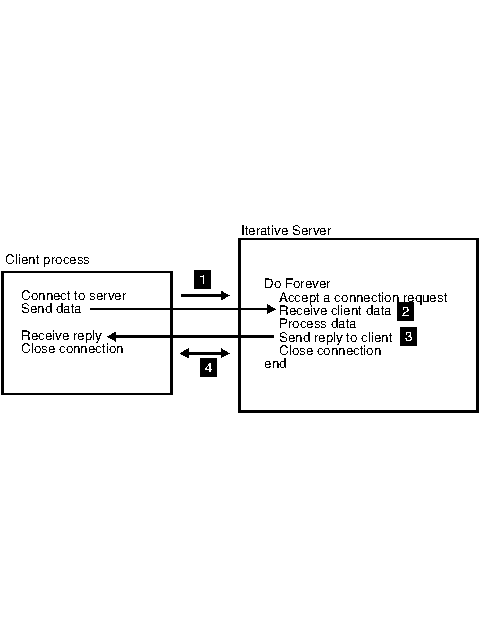 z/OS Communications Server: IP Sockets Application Programming Interface Guide and Reference
z/OS Communications Server: IP Sockets Application Programming Interface Guide and Reference
 z/OS Communications Server: IP Sockets Application Programming Interface Guide and Reference
z/OS Communications Server: IP Sockets Application Programming Interface Guide and Reference
|
Previous topic |
Next topic |
Contents |
Contact z/OS |
Library |
PDF
Client/server socket programs: Iterative server socket programs z/OS Communications Server: IP Sockets Application Programming Interface Guide and Reference SC27-3660-00 |
|
|
An iterative server processes requests from clients in a serial manner; one connection is served and responded to before the server accepts a new client connection. Figure 1 shows the iterative server
main logic.
Figure 1. Iterative server
main logic
 The following list describes the iterative server socket process.
An MVS™ iterative server can be implemented as follows:
From a socket programming perspective, there is no difference between an iterative server that runs in a native MVS environment (batch job, started task, or TSO) and one that runs as a CICS task, or as a BMP under IMS. You can terminate the server process in various ways. For jobs that execute in traditional MVS address spaces (batch job, started task, TSO, IMS BMP), you can implement functions in the server to enable an operator to use the MVS MODIFY command to signal stop; for example F SERVER,STOP. (This technique cannot be used for CICS tasks.) Alternatively, you can include a shutdown message in the application protocol. By doing so, you can develop a shutdown client program that connects to the server and sends a shutdown message. When the server receives a shutdown message from a socket client, it terminates itself. 


|
 Copyright IBM Corporation 1990, 2014 Copyright IBM Corporation 1990, 2014 |